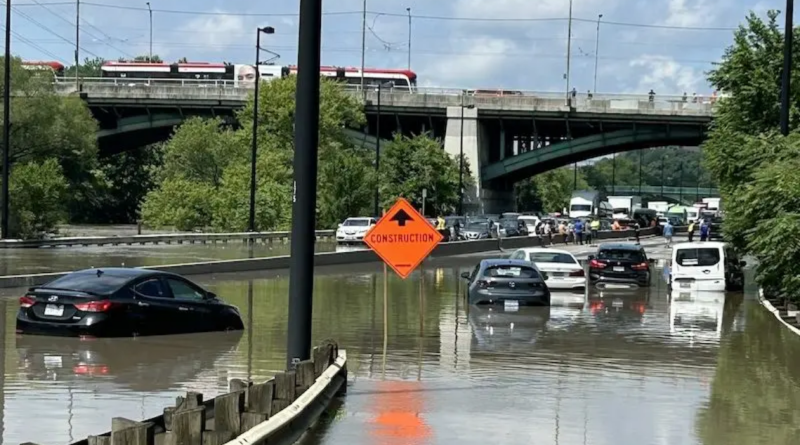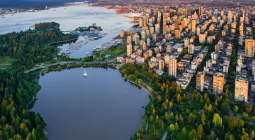Ringing Cities with Belts of Green and Blue Can Counter Heat, Flooding

Cities can cool down by ringing their boundaries with a thick belt of green space, ideally threaded through with lakes and rivers, says the latest research out of China.
Cooling trees and water—even if they’re on the periphery—can reduce the urban heat island effect by 0.5℃, writes former Guardian columnist and Climate News Network joint editor Paul Brown.
Brown cites a study recently published by the journal Nature Cities, by a research team from the Jiangsu Province Engineering Research Center of Urban Heat and Pollution Control in Nanjing, China, with collaborators from the University of Surrey in the U.K. and Concordia University in Montreal.
“A reduction in temperature of 0.5℃ may not sound like much, but with cities getting hotter as the climate warms, it could save the lives of elderly people and young children,” Brown writes.
While climate change affects the entire planet, cities are warming faster than rural areas, courtesy of the urban heat island (UHI) effect: the impact that hard, typically dark, heat-absorbing surfaces like roads and roofs have on local temperatures. Waste or lost heat from cars, factories, and appliances like air conditioners also contribute to the UHI effect.
Currently raising city temperatures by as much as 3℃, the UHI effect is “already making life uncomfortable for millions worldwide and causing an increasing number of deaths,” notes Brown.
Published in July, the Nanjing study analyzed geographic and environmental data collected between 2000 and 2020 from 30 Chinese cities. It found that those with wide belts of trees and large lakes on their immediate borders had significantly cooler city centres than those without.
The research team quantified the relation between the thickness of this greenbelt (technically known as neighbouring rural land cover, or NRLC, and containing cropland, grassland, and its own “impervious surfaces”) and the extent of UHI mitigation. It found that NRLC belts as wide as “approximately half of the equivalent diameter” of the city that lies within them lowered city centre temperatures by as much as 0.5℃.
And greenbelts within a 10- to 15-kilometre radius of an urban boundary “can contribute up to 30% [or 0.5℃] to the reduction of UHI in urban centres.”
That a continuous, thick, and unfragmented doughnut of green and blue can so significantly cool a city at its core owes to “heat island circulation”—a phenomenon that “holds paramount importance in urban ventilation and the exchange of energy between urban and rural environments.”
Heat island air circulation occurs via convection (when the hot air rises, “creating a low-pressure zone near the ground”) followed by diffusion, which causes hot air to be transported to rural regions, even as cooler air from these regions is drawn in by the pressure differential to take its place.
That dynamic translates into “a good case for ringing cities with parks,” writes Brown.
Many cities grappling with extreme heat around the world are also trying to come to grips with severe storms and consequent flooding.
Toronto, for example, Toronto saw punishing heat in June give way to spectacular flooding on July 16 when a summer storm dropped 84 millimetres of rain on the downtown core in just a few hours, delivering the fifth-wettest day in the city’s history.
The deluge, which left parts of the Don Valley Expressway submerged for hours, moved Mayor Olivia Chow’s administration to take an urgent look at stormwater mitigation and adaptation in Toronto, and promise to get back to City Council with solutions.
Toronto’s efforts to deal with urban flooding have been a long time incubating, writes Elliott Cappell, PwC Canada’s national climate change leader and the City of Toronto’s former resilience officer, in a recent op ed in the Globe and Mail. And the city still has a long way to go on nailing down the “ways and means” of keeping dry.
Getting clarity on the “ways” will require Toronto, alongside many of its North American peers, to replace its “keep water out” mindset with the “uber-Dutch mantra: ‘Let the water in’,” Cappell writes. He cites Manhattan’s Dutch-based flood control project, The BIG U, as case in point.
As for “the means,” Toronto needs to address the question of who pays, Cappell says.
“There are four parties who principally pay for urban flooding cleanup: taxpayers, property owners, insurers, and infrastructure owners. Those groups will either have to pay now or pay later, so they should have a say in whether and how to pay for resilience.”
Cappell says he is “not necessarily advocating for the ‘rain tax’,”, the stormwater management fee that many jurisdictions charge property owners. “But one way or another, we will need to find the means for the ways,” he writes.





